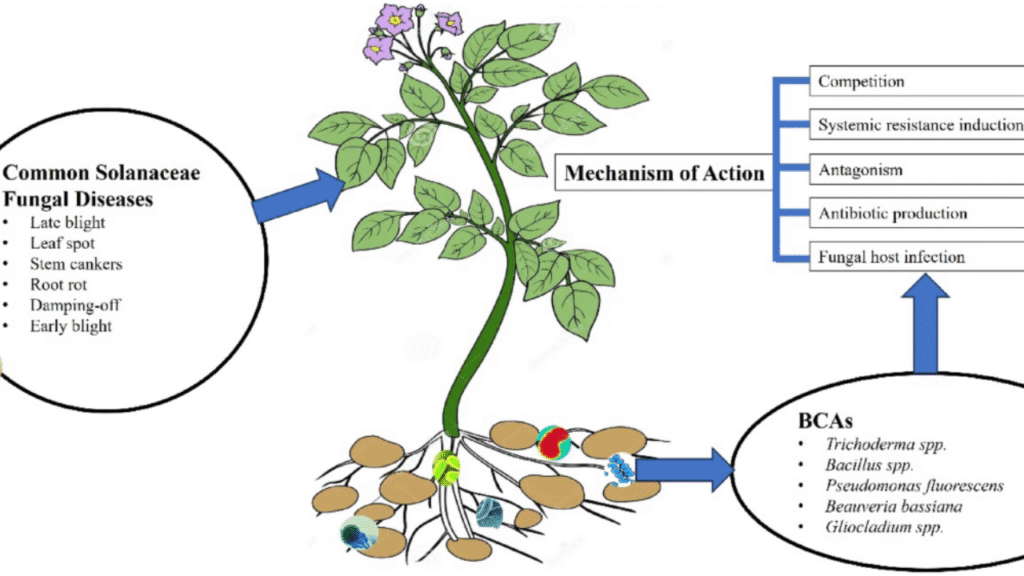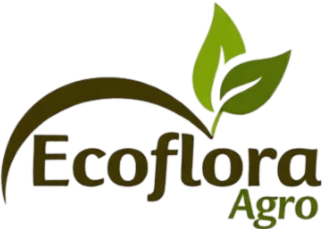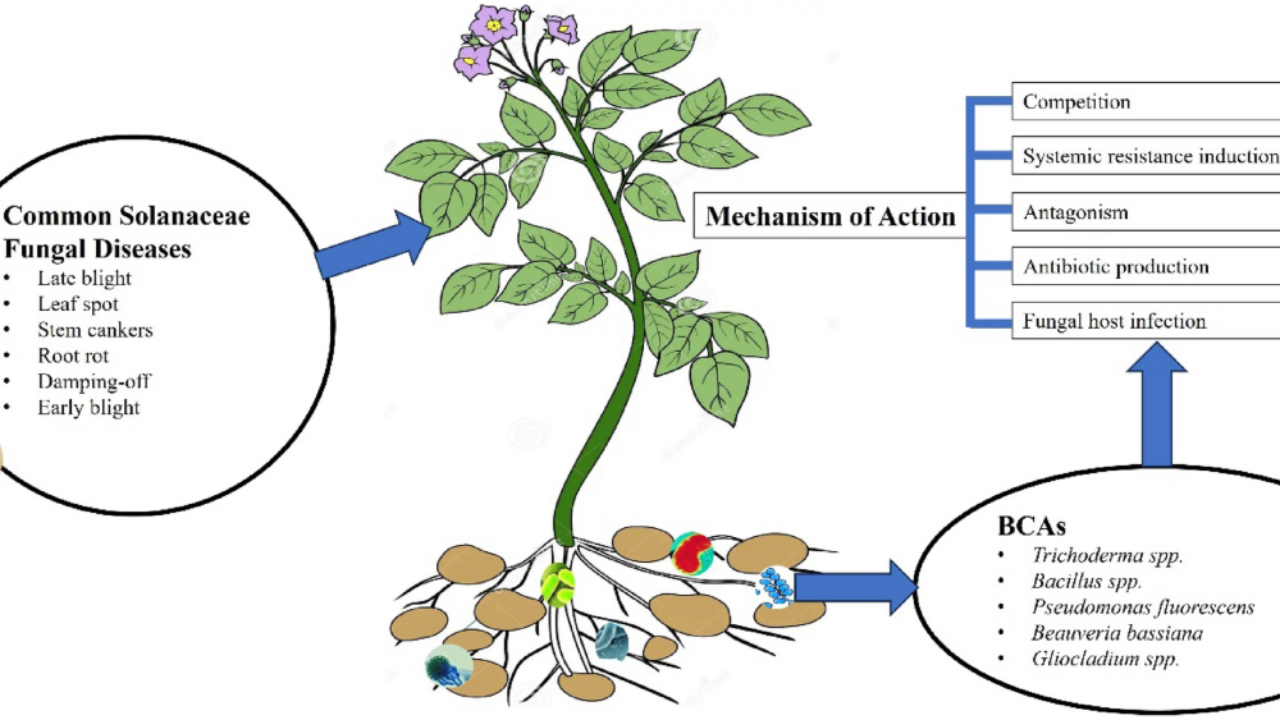
As agriculture shifts towards eco-friendly and sustainable practices, botanical fungicides—plant-based alternatives to chemical fungicides—are gaining popularity. These natural solutions offer effective fungal disease control while reducing environmental impact and health risks. Certain plants produce bioactive compounds that inhibit or kill fungal pathogens, making them valuable tools in integrated pest management systems. This article explores the top five plants used in botanical fungicides, detailing their mechanisms, applications, and potential.
Overview Table: Top Plants in Botanical Fungicides
| Plant Name | Common Uses | Active Compound(s) | Mechanism of Action | Target Fungal Pathogens | Application Form |
|---|---|---|---|---|---|
| Neem (Azadirachta indica) | Broad-spectrum fungicide | Azadirachtin, Nimbin | Inhibits spore germination and fungal growth | Powdery mildew, anthracnose | Oil, extract |
| Garlic (Allium sativum) | Antifungal & antibacterial | Allicin | Disrupts fungal cell membrane integrity | Botrytis, Fusarium spp. | Juice, macerate |
| Turmeric (Curcuma longa) | Anti-microbial agent | Curcumin | Suppresses fungal enzymes and proteins | Rhizoctonia, Pythium | Powder, decoction |
| Lemongrass (Cymbopogon citratus) | Fungal growth inhibitor | Citral, Geraniol | Destroys hyphal structure and spore formation | Aspergillus, Penicillium | Essential oil, spray |
| Marigold (Tagetes spp.) | Soil fungicide | Thiophenes, Lutein | Toxic to fungal spores and root pathogens | Fusarium, Sclerotium | Powder, compost mix |
1. Neem (Azadirachta indica): The All-Rounder Biocontrol Agent
Neem is one of the most celebrated plants in organic pest management, including as a fungicide. The bioactive components, especially azadirachtin, nimbin, and salannin, act as antifungal agents.
Mechanism of Action:
- Inhibits fungal spore germination
- Disrupts fungal metabolic pathways
- Prevents growth of fungal hyphae
Applications:
- Used in oil or extract form
- Effective against anthracnose, rusts, powdery mildew, and leaf spots
Benefits:
- Safe for beneficial insects
- Non-toxic to humans and animals
2. Garlic (Allium sativum): Nature’s Antimicrobial Weapon
Garlic has been traditionally used for its medicinal properties, including its strong antifungal capacity due to allicin, a sulfur-containing compound.
Mechanism of Action:
- Penetrates fungal cell walls and membranes
- Causes leakage of cellular contents
- Interrupts spore development
Applications:
- Crushed garlic or juice used as foliar spray
- Effective against Botrytis cinerea, Fusarium spp., and damping-off pathogens
Benefits:
- Easily available and biodegradable
- Also acts as an insect and bacterial deterrent
3. Turmeric (Curcuma longa): The Golden Shield
Turmeric is widely known for its antimicrobial properties. Curcumin, its primary active ingredient, is an antifungal agent effective against various soil-borne fungi.
Mechanism of Action:
- Inhibits key fungal enzymes and metabolic processes
- Acts as an antioxidant to boost plant resistance
Applications:
- Turmeric powder or water-based decoction sprayed on plants
- Used in seed treatment and soil drenching
Benefits:
- Reduces dependency on synthetic soil fungicides
- Enhances plant immunity
4. Lemongrass (Cymbopogon citratus): The Hyphal Disruptor
Lemongrass contains citral and geraniol, essential oils with strong antifungal activity. It is effective in managing post-harvest fungal infections and foliar diseases.
Mechanism of Action:
- Disrupts the fungal cell membrane structure
- Prevents fungal sporulation and colony development
Applications:
- Lemongrass essential oil diluted and sprayed
- Also used as vapor treatment for post-harvest produce
Benefits:
- Pleasant aroma and dual-use as insect repellent
- Prevents spread of storage fungi
5. Marigold (Tagetes spp.): The Soil Detoxifier
Marigold is more than just a decorative plant. It produces thiophenes and lutein, which are highly toxic to soil-borne fungi.
Mechanism of Action:
- Inhibits germination of fungal spores
- Acts as a root-zone fungistatic agent
Applications:
- Marigold extracts, powders, or residues incorporated into compost
- Used as green manure in crop rotation systems
Benefits:
- Improves soil health
- Controls nematodes in addition to fungi
Comparative Table: Effectiveness by Fungal Type
| Fungal Disease Type | Most Effective Plant(s) | Application Method |
|---|---|---|
| Powdery Mildew | Neem, Turmeric | Foliar spray |
| Damping-Off | Garlic, Marigold | Soil treatment |
| Anthracnose | Neem, Lemongrass | Foliar spray |
| Root Rot (Fusarium) | Garlic, Marigold, Turmeric | Soil drenching/green manure |
| Post-Harvest Mold (Aspergillus) | Lemongrass, Turmeric | Vapor or oil treatment |
Key Advantages of Using Botanical Fungicides
- Eco-friendly: Decompose easily without polluting soil or water.
- Biodegradable: Leave no toxic residues on crops.
- Resistance Management: Help reduce resistance buildup common with synthetic fungicides.
- Safe: Non-toxic to humans, animals, and pollinators.
Conclusion
Botanical fungicides derived from plants like neem, garlic, turmeric, lemongrass, and marigold present a sustainable and effective strategy to manage fungal diseases in agriculture. Their natural origin, low toxicity, and multiple action mechanisms make them ideal components of integrated disease management (IDM). With increasing demand for residue-free produce and eco-farming practices, these plants are set to play a larger role in the future of crop protection.
FAQs
Q1: Can botanical fungicides replace synthetic fungicides completely?
They can replace or reduce reliance on synthetic fungicides in many cases, especially in organic and small-scale farming.
Q2: Are botanical fungicides safe for edible crops?
Yes, they are generally non-toxic and safe for edible plants and produce.
Q3: How often should botanical fungicides be applied?
Application frequency varies by plant type and disease pressure but is typically every 7–14 days for prevention.

